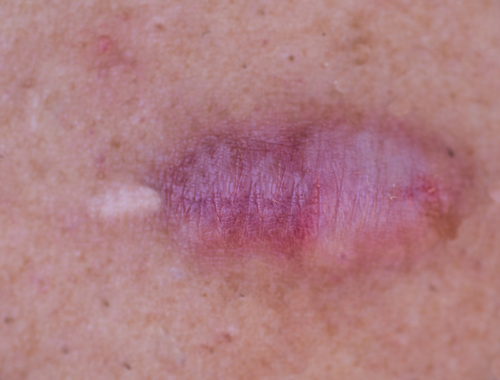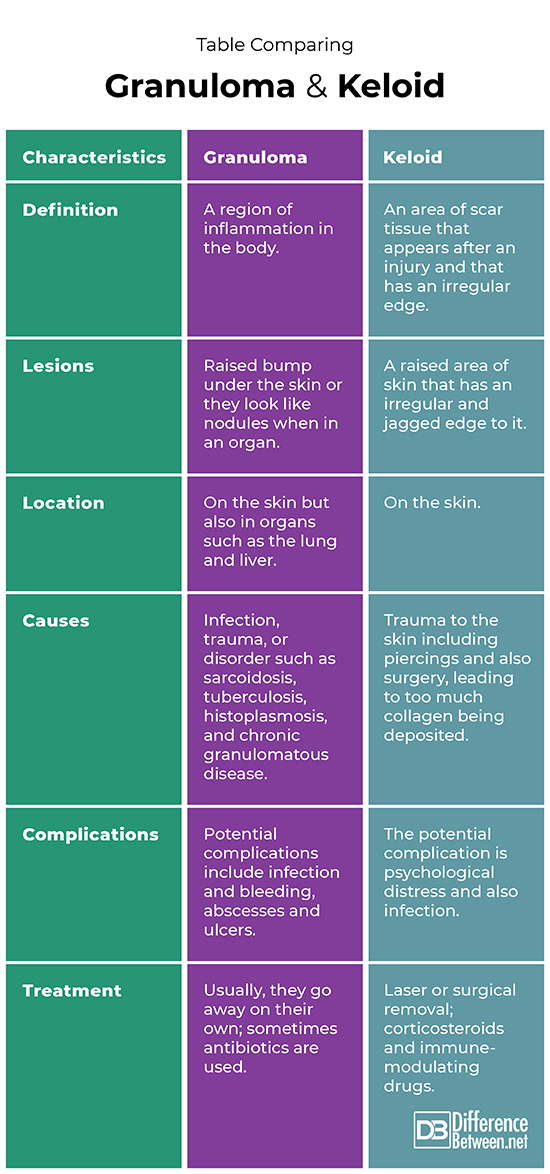Difference Between Granuloma and Keloid
A granuloma is an inflamed piece of tissue that can occur in the skin or in an organ. A keloid is a type of scar that forms on the skin after some trauma.

What is Granuloma?
Definition:
A granuloma is a region of tissue where inflammation has occurred.
Causes:
An injury is often the reason for a granuloma developing. It can also occur when the body is exposed to something foreign, for instance, the ink of a tattoo. They often occur in the lungs and could be due to the body trying to section off an area of bacteria or fungi. Granulomas can also be due to diseases like sarcoidosis, tuberculosis, histoplasmosis, and chronic granulomatous disease.
Symptoms and complications:
If on the skin, a granuloma may appear as itchy bumps. If inside the body, there may be no symptoms but this may depend on where the granuloma is and how big it is. For instance, a lung granuloma could cause dyspnea and chest pain. Granulomas can also be found in the liver leading to hepatitis. Where a granuloma is due to foreign material, ulcers and abscesses can form, which can become infected; this is especially the case for people who have chronic granulomatous disease.
Diagnosis:
A granuloma can be diagnosed a number of ways including by needle biopsy, and imaging tests such as CT scan or X-ray.
Treatment:
Often a granuloma will go away on its own, especially if it is on the skin. In other cases, such as for those who have chronic granulomatous disease, antibiotics may be used.

What is Keloid?
Definition:
A keloid is scar tissue that forms on the skin during the healing process.
Causes:
Keloids are caused by too much collagen being formed in the skin and it is triggered due to some type of trauma to the skin. A piercing can be an example of an event that triggers keloid formation. Collagen is a natural connective tissue of the skin but when in excess, collagen can cause these unsightly scars. They can also happen after a surgical cut or animal bite.
Symptoms and complications:
A keloid appears as an elevated area of skin that is a darker color than nearby skin. Keloids can be painful and bleed. They also usually have an uneven irregular edge to them and a person may find them itchy. A person may worry about their appearance because of the keloids. A possible complication is an infection in the skin.
Diagnosis:
A doctor can normally tell that the abnormal skin is a keloid but a biopsy can rule out any other issues and confirm that it is a keloid.
Treatment:
Keloids can be removed by laser or surgical excision. Medications that ae helpful include immunomodulators and corticosteroids.
Difference between Granuloma and Keloid?
Definition
A granuloma is a region of the body where there is an inflammatory response. A keloid is a type of scar that forms.
Lesions
A granuloma looks like a red bump. A keloid is a raised section of skin that has a jagged and irregular type of margin.
Location
You can find a granuloma on the skin but also in internal organs like the lungs and liver. A keloid is only ever found on the skin.
Causes
Infection, trauma, or disorders such as sarcoidosis, tuberculosis, histoplasmosis, and chronic granulomatous disease can all cause a granuloma to form. Trauma to the skin can result in keloid formation when excess collagen is produced.
Complications
Potential complications of a granuloma include infection and bleeding. Psychological distress is a complication of a keloid.
Treatment
Granulomas usually heal and go away without further treatment; sometimes antibiotics are used. Keloids can be treated with corticosteroids or removed by a laser or surgery.
Table comparing Granuloma and Keloid

Summary of Granuloma Vs. Keloid
- A granuloma is a bump that is created in response to an injury or disorder.
- A keloid is a scar produced when too much collagen is produced.
- Granulomas often go away on their own but a keloid does not.
- Keloids grow slowly but persist and are difficult to treat.
FAQ
How do you tell if a lump is a keloid?
Keloids take time to develop and have an irregular edge. However, it is always best to confirm the diagnosis with a doctor.
What is a granuloma on a piercing?
This is a red-colored bump that develops where you have had a piercing done.
Are keloids hard or soft?
The texture of keloids varies quite a lot so they can be soft but they can also be hard.
How do you differentiate a keloid?
A keloid has raised irregular edges to it.
What can be mistaken for keloids?
The rare disorder called dermatofibrosarcoma protuberans can be confused with keloids.
What are the beginning stages of a keloid?
The skin in the area where the keloid is starting will feel rubbery and hard. It may also, initially, be red or purple in color, later turning brown.
- Difference Between Rumination and Regurgitation - June 13, 2024
- Difference Between Pyelectasis and Hydronephrosis - June 4, 2024
- Difference Between Cellulitis and Erysipelas - June 1, 2024
Search DifferenceBetween.net :
Leave a Response
References :
[0]Chike-Obi, Chuma J., Patrick D. Cole, and Anthony E. Brissett. "Keloids: pathogenesis, clinical features, and management." Seminars in plastic surgery. Vol. 23. No. 03. © Thieme Medical Publishers, 2009.
[1]Holland, Steven M. "Chronic granulomatous disease." Hematology/Oncology Clinics 27.1 (2013): 89-99.
[2]Metts, Julius. "Common complications of body piercing." Western journal of medicine 176.2 (2002): 85.
